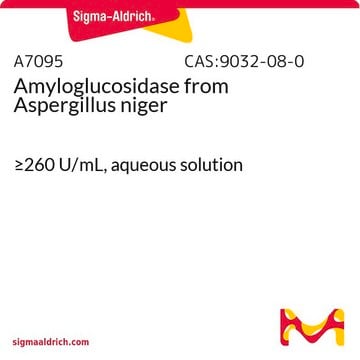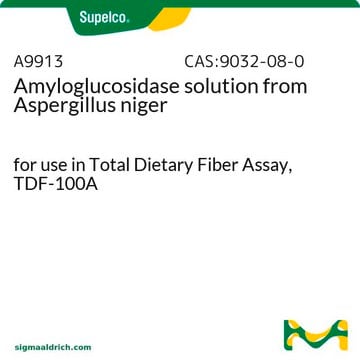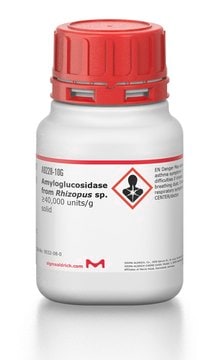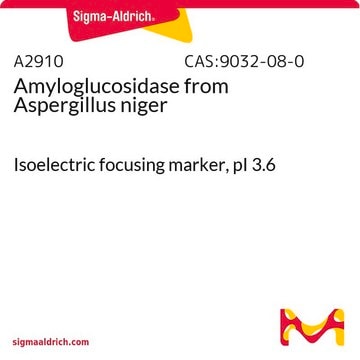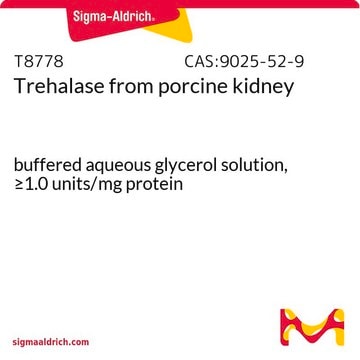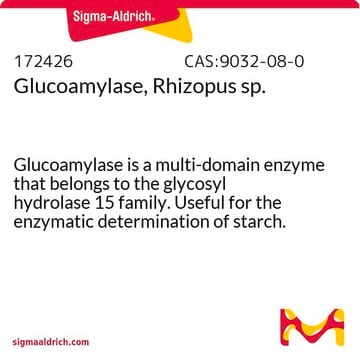This product is filled by density, with a target fill volume of 0.5 ml for the 25mg and 2.0 ml for the 100mg package sizes.
A1602
Amyloglucosidase from Aspergillus niger
ammonium sulfate suspension, ≥40 units/mg protein
Synonym(s):
1,4-α-D-Glucan glucohydrolase, Exo-1,4-α-glucosidase, Glucoamylase
About This Item
Recommended Products
form
ammonium sulfate suspension
Quality Level
specific activity
≥40 units/mg protein
shipped in
wet ice
storage temp.
2-8°C
Looking for similar products? Visit Product Comparison Guide
General description
Application
Biochem/physiol Actions
Unit Definition
Physical form
Other Notes
Storage Class Code
12 - Non Combustible Liquids
WGK
WGK 2
Flash Point(F)
Not applicable
Flash Point(C)
Not applicable
Personal Protective Equipment
Certificates of Analysis (COA)
Search for Certificates of Analysis (COA) by entering the products Lot/Batch Number. Lot and Batch Numbers can be found on a product’s label following the words ‘Lot’ or ‘Batch’.
Already Own This Product?
Find documentation for the products that you have recently purchased in the Document Library.
Customers Also Viewed
Articles
Instructions for working with enzymes supplied as ammonium sulfate suspensions
Protocols
This procedure may be used for the determination of Amyloglucosidase activity using starch as the substrate.
-
What volume of ammonium sulfate is the 25mg suspended in?
1 answer-
Helpful?
-
-
How can a 1mg/mL solution of amyloglucosidase A1602 be prepared in acetate buffer?
1 answer-
The product A1602 is in an ammonium sulfate solution. Here's how you can work with this product:
- If the ammonium sulfate might interfere with the reaction(s):
1. Remove the enzyme from the refrigerator, ensuring that the ammonium sulfate suspensions are not frozen.
2. Gently invert the vial or bottle to produce a milky suspension. Avoid using harsh treatments like vortexing or sonicating, as they may denature some of the enzyme.
3. Use a pipette and sterile wide-bore pipette tip to remove a portion of the suspension.
4. Transfer the portion to a clean microcentrifuge or centrifuge tube.
5. Pellet the enzyme by centrifuging at approximately 10,000 – 15,000 x g for 10 minutes, if possible, using a refrigerated microcentrifuge set to a temperature between 2 °C and 8 °C.
6. Carefully remove as much clear supernatant as possible, retaining it; it is not necessary to remove absolutely all of the ammonium sulfate solution.
7. Dissolve the pellet by adding an appropriate amount of reaction buffer.
8. Assay the supernatant and the solution from the pellet for protein content and/or enzyme activity.- If the ammonium sulfate will not interfere with the reaction(s), follow the same steps as above.
It's important to note that for an ammonium sulfate suspension, most of the enzyme will be in solid form, and only negligible amounts of enzyme will likely be in the ammonium sulfate solution.
Alternatively, there are several Amyloglucosidase enzymes available in solid form (e.g., Product A7420 and A9228) that can be suspended in a solvent of your choice.
Helpful?
-
Active Filters
Our team of scientists has experience in all areas of research including Life Science, Material Science, Chemical Synthesis, Chromatography, Analytical and many others.
Contact Technical Service